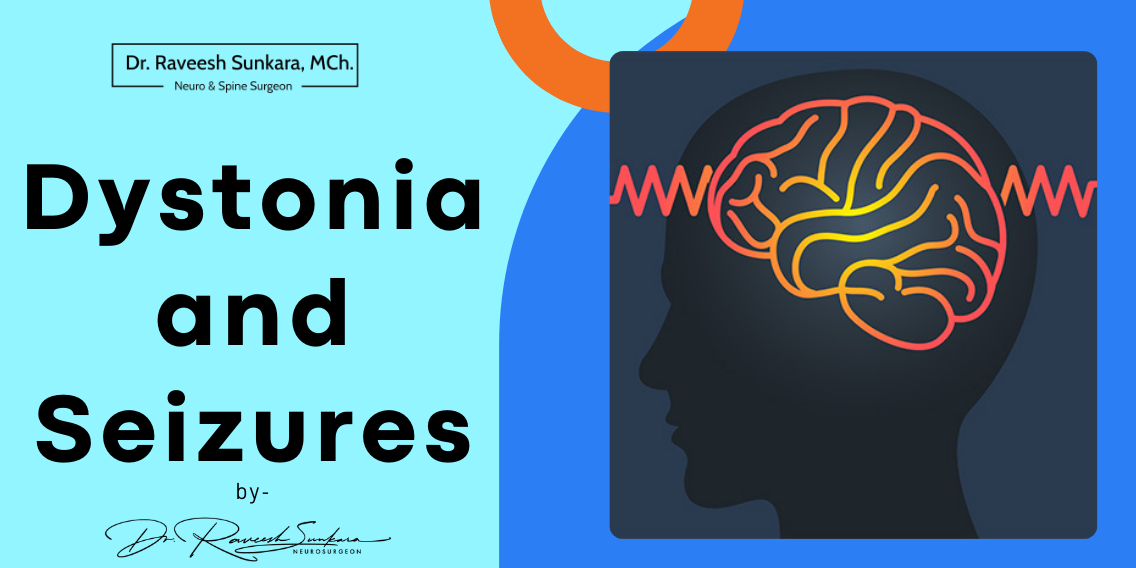The intersection of dystonia and seizures presents a complex puzzle for patients and physicians alike. The incidence of primary dystonia is approximately 16.4 / 100,000 persons globally. Dystonia is characterized by involuntary muscle contractions causing repetitive movements or abnormal postures.

“Abnormal or dystonic postures often coexist with seizures”, explains renowned neurosurgeon Dr. Raveesh Sunkara. “Seizures are sudden, uncontrolled electrical disturbances in the brain. Understanding this relationship is crucial for effective diagnosis and treatment.”
Dr. Raveesh Sunkara is known to many as the best neurosurgeon in Hyderabad. He specializes in helping people with these conditions. He offers comprehensive care and guidance in managing dystonia and seizures. His expertise can shed light on the connection between these neurological conditions. Dr. Sunkara can help you manage these challenges and improve your neurological health.
Take the first step towards better neurological health with Dr. Sunkara’s guidance. Contact us now!
Curious about abnormal or dystonic posturing in seizures? Let’s unravel the mysteries behind these involuntary muscle movements during seizure activity.
Understanding Dystonic Posturing In Seizures

Dystonic posturing refers to involuntary muscle contractions that occur during seizure activity. These contractions can cause limbs, trunk, or neck muscles to twist or contort abnormally. It’s a distinct manifestation often seen in certain types of seizures. It indicates the involvement of the motor regions of the brain.
But what causes dystonia?
Various neurological disorders can lead to dystonia including:
- Parkinson’s disease
- Huntington’s disease
- Cerebral palsy
“Each condition affects different areas of the brain”, says the top neurosurgeon in Hyderabad, Dr. Raveesh Sunkara. “They result in abnormal movements and postures characteristic of dystonia.”
He further explains:
“Dystonia stems from dysfunction in the basal ganglia. Basal ganglia are a group of structures deep within the brain involved in motor control. Damage or dysfunction in this region disrupts the balance of neurotransmitters. This imbalance can lead to excessive muscle contractions and involuntary movements.”
Continue reading to better understand and navigate the complexities of dystonia and seizures!
Difference Between Dystonia and Seizures
Embark on a journey to unravel the nuances between dystonia and seizures. Here’s a breakdown of the key differences between these two neurological conditions:
- Dystonia is a movement disorder characterized by sustained or intermittent muscle contractions. It results in abnormal postures or repetitive movements.
- Seizures are sudden, uncontrolled electrical disturbances in the brain. They often cause altered consciousness or convulsions.
2. Dystonia primarily affects voluntary muscles, leading to twisting or repetitive movements.
- Seizures can manifest in various ways. They include muscle rigidity, jerking movements, or sensory disturbances.
3. Dystonic movements tend to be more prolonged and repetitive.
- Seizures typically have a sudden onset and may resolve relatively quickly.
4. Dystonia is often triggered or worsened by specific movements or postures.
- Seizures can occur spontaneously or in response to specific triggers. They include stress, sleep deprivation, or flashing lights.
5. Dystonia does not usually involve changes in consciousness.
- Seizures can cause alterations in awareness, memory, or sensory perception.
Do you want to learn more about the contrasts between dystonia and seizures?
Please schedule a consultation with Dr. Raveesh Sunkara, a reputed neurosurgeon in Hyderabad. He is highly experienced and can provide personalized insights and guidance.
Next, let’s unravel the diverse manifestations of dystonia.
Types of Dystonia and Associated Seizures

Below are the various types of dystonia, each presenting with unique symptoms and challenges:
Cervical dystonia:
- Involves involuntary contractions of neck muscles
- Causes the head to twist or turn involuntarily
Blepharospasm:
- Characterized by involuntary eyelid spasms
- Leads to repetitive blinking or closure of the eyes
Oromandibular dystonia:
- Affects the muscles of the face and jaw
- Causes involuntary movements or spasms that can interfere with speech, eating, or facial expression
Writer’s cramp:
- Occurs when dystonia affects hand or forearm muscles
- Leads to difficulty in writing or performing fine motor tasks
Focal dystonia:
- Refers to dystonia that affects specific body regions, such as the hand, foot, or vocal cords
- Results in abnormal movements or postures localized to that area
Generalized dystonia:
- Involves widespread muscle contractions affecting multiple body regions
- Leads to severe and often disabling symptoms
Now, let’s learn about a few associated seizures of dystonia.
Faciobrachial dystonia:
Faciobrachial dystonia is a rare form of focal dystonia. It is characterized by sudden, involuntary movements affecting the face and arms. It often manifests as brief episodes of repetitive or jerky movements involving:
- Grimacing
- Blinking
- Flailing of the arms

Myoclonic dystonia epilepsy:
A rare genetic disorder, it’s characterized by a combination of myoclonic seizures, dystonia, and epilepsy. Individuals with this condition experience sudden, brief muscle jerks (myoclonus). These are accompanied by involuntary muscle contractions (dystonia) and seizures.
Myoclonus dystonia seizure:
It’s a type of seizure characterized by sudden, involuntary muscle jerks (myoclonus) and dystonic movements. These seizures can vary in severity and frequency. They often cause significant functional impairment and challenges in daily life.
Do you have reason to believe you may have any of these conditions?
Do not delay in seeking medical intervention. Connect with Dr. Raveesh Sunkara, a highly skilled neurological expert in Hyderabad. He can provide effective strategies to manage your neurological condition and improve your quality of life.
Read on as we unlock the complexities of dystonic seizures and their symptoms.
Dystonic Seizure Symptoms and Warning Signs

Here’s a breakdown of the distinctive signs and manifestations:
Involuntary muscle contractions:
Dystonic seizures typically involve sudden, involuntary muscle contractions. This can lead to twisting or abnormal postures of the limbs, neck, or trunk.
Repetitive movements:
Patients may experience repetitive or jerky movements of the affected body parts during a dystonic seizure.
Muscle stiffness:
There may be increased resistance to movement, making it difficult to perform certain tasks.
Pain or discomfort:
Patients may experience persistent muscle pain or discomfort, especially in the affected areas.
Changes in posture or gait:
It can cause alterations in posture or walking patterns due to muscle contractions or spasms.
Functional impairment:
A dystonic seizure can cause challenges in performing daily activities or tasks due to muscle-related symptoms.
Altered consciousness:
Some individuals may experience changes in awareness or responsiveness during the seizure.
Vocalizations:
In some cases, dystonic seizures may be accompanied by involuntary vocalizations or sounds, such as grunts or moans.
Sensory symptoms:
Patients may report sensory disturbances during a dystonic seizure. These include tingling sensations, numbness, or unusual perceptions of touch or pain.
Duration:
Dystonic seizures can vary in duration. Some last only a few seconds to minutes, while others may persist for longer periods.
Recovery period:
Following a dystonic seizure, individuals may experience a brief recovery period characterized by:
- fatigue
- confusion
- muscle weakness
Have you or a loved one experienced any of these symptoms?
Do reach out to an experienced neurologist like Dr. Raveesh Sunkara.
Don’t let discomfort linger—understand the symptoms today and take action for relief! It’s time to discover innovative treatment options.
Dystonic Seizures – Treatment Options
Treatment for dystonic seizures involves a variety of approaches tailored to individual needs. Here are some key treatment options to consider:

Medication:
Neurologists often prescribe antiepileptic drugs to manage dystonic seizures. The aim is to reduce seizure frequency and severity.
Deep brain stimulation (DBS):
DBS surgery involves implanting electrodes in specific brain regions. The aim is to modulate abnormal electrical activity and alleviate seizure symptoms.

Physical therapy:
Therapists employ targeted exercises and techniques to help patients improve:
- Muscle strength
- Flexibility
- Coordination
Botulinum toxin injections:
Injecting botulinum toxin into affected muscles can temporarily reduce muscle contractions. This helps alleviate dystonic symptoms.

Lifestyle modifications:
Certain lifestyle changes can help manage dystonic seizures effectively. These include maintaining a healthy lifestyle and avoiding triggers such as:
- Stress
- Fatigue
- Certain medications
Supportive therapies:
Patients can get help coping with the emotional and psychological impact of dystonia and seizures through:
- Psychological counseling
- Support groups
- Relaxation techniques
Are you ready to explore personalized treatment options for dystonia?
Please schedule an appointment with Hyderabad’s respected neurosurgeon Dr. Raveesh Sunkara.
Conclusion
Dealing with dystonia and seizures can be quite challenging. It’s important to understand the different ways dystonia can show up and how seizures happen. Proper treatment involves a mix of medications, surgeries, and therapies to support patients along the way. While it’s not always easy, there are ways to manage symptoms and improve quality of life.
Dr. Raveesh Sunkara, a neurosurgical expert in Hyderabad, is spreading awareness and supporting research. He is making strides to help those facing dystonia and seizures feel supported and hopeful for the future.
Are you dealing with dystonia and seizures? Please contact Dr. Raveesh Sunkara for expert guidance and support.
Don’t let dystonia hold you back! Take proactive steps towards a brighter, more manageable future.
Explore our FAQs for answers to common questions.
FAQ
Is dystonia brain damage?
No, dystonia isn’t brain damage. It’s a neurological disorder characterized by involuntary muscle contractions.
What neurotransmitters are involved in dystonia?
Dopamine and acetylcholine are key neurotransmitters involved in dystonia. They regulate muscle movement and coordination.
What happens if dystonia is left untreated?
Untreated dystonia can lead to:
1. Worsening symptoms
2. Decreased quality of life
3. Difficulty performing daily activities
Can you live a long life with dystonia?
Yes, with proper management and treatment, individuals with dystonia can live a long and fulfilling life. However, the condition may present ongoing challenges.
Is dystonia linked to seizures?
Yes, seizures can sometimes cause dystonia. Dystonia is a movement disorder that can occur after certain types of seizures, especially those affecting areas of the brain responsible for motor control. However, this is not common, and when it happens, it is typically linked to underlying neurological conditions.
What causes dystonia to occur?
Dystonia can be triggered by various factors, including genetic mutations, brain injuries, infections, or exposure to certain medications. Stress, fatigue, or repetitive movements may also worsen symptoms.
Reference Links:
https://www.sciencedirect.com/topics/medicine-and-dentistry/paroxysmal-dystonia#
https://www.mayoclinic.org/diseases-conditions/dystonia/symptoms-causes/syc-20350480#







